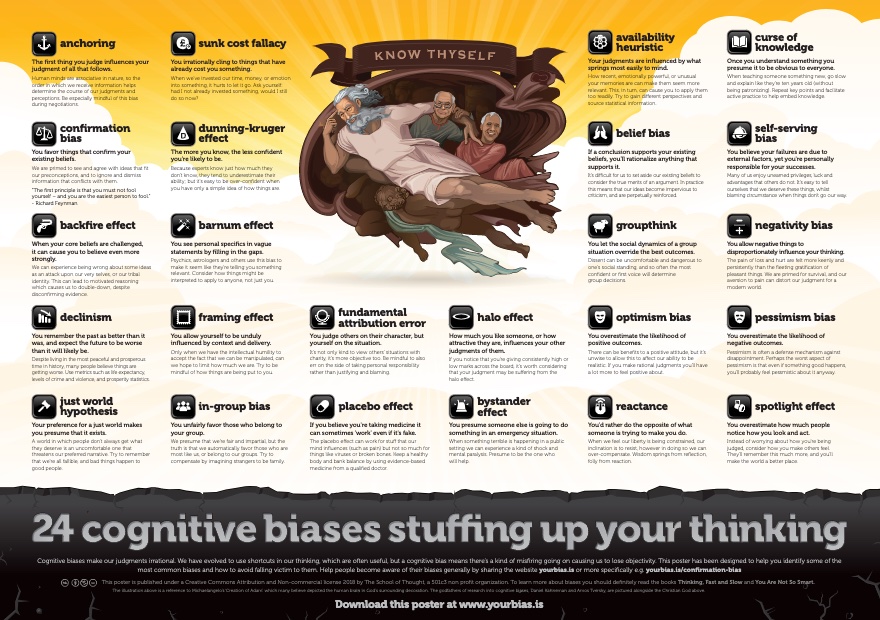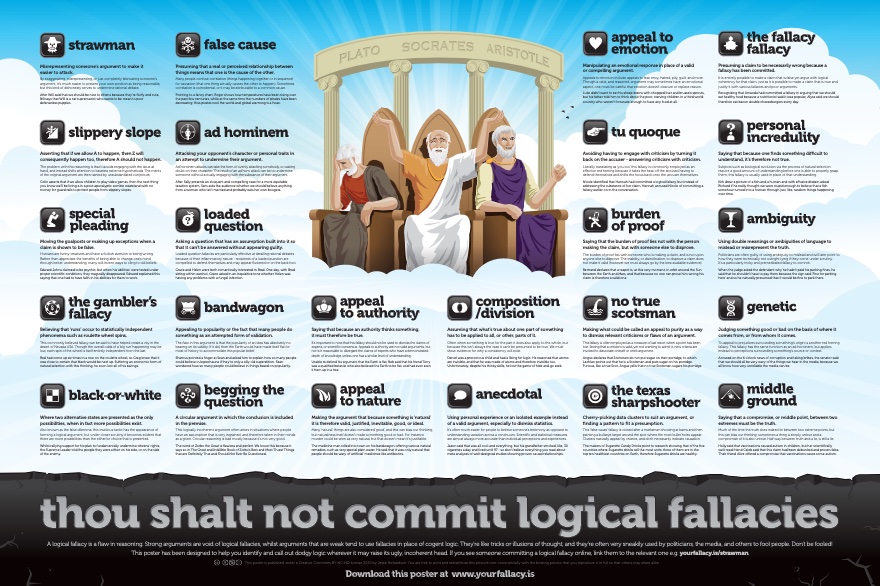Our Aussie friends over at SchoolOfThought.org (Jesse Richardson and team) created these two amazing posters below. They’re designed for high school kids and all the rest of us too.
They brilliantly organize the things we humans have learned over the past 2500 years about the way we think and the ways we can use these tools to sort out our complicated world. They can also be used to trick and manipulate people, of course.
This is your one stop shop for all such things and there’s really no need to dive any deeper than this.
These ideas and principles are at the core of the scientific method, our legal system, reliable internet, your cellphone and computer, our safe food, water and power supply, modern medicine, the financial system, reliable and safe airline travel, and so much more.
Human beings are messy, but on this website you’re experiencing the ways we can get a practical grip on things in our lives and give ourselves great traction using these very principles. It doesn’t require being a college educated nerd.
These cool and fun posters are focused on two kinds of things – the ways we can confuse ourselves, and the ways others can confuse us.
Zoom into these posters and you’ll be able to easily explore all of the poster maker’s hard work to make it easy and fun to learn about this stuff, or to refresh your memory.
By the way, these are PDF files so they’ll be clear and crisp no matter how much you zoom in.
On a phone or tablet, tap on the image, then pinch, zoom and drag all over it, then hit the back arrow on your browser to return here
On your computer, click on the image, then use the + and – to zoom in and out, and your mouse to scroll around in it. Close the window to return here. Hit the back arrow in the browser to return here.
What are we noticing?
We’re noticing how this all fits together and the foundations upon which the Confusion Buster Cards™ are based.
We’re also noticing that we call this the “Clear Thinking” Campaign – not the “Critical Thinking” Campaign. That’s because “Critical Thinking” sounds like we’re in school and it’s going to make us yawn and reach for our phones and check out Instagram or go watch videos.
It’s ironic that the people who who’ve mastered all of this academic critical thinking stuff are committing one of the biases listed below – the Blindness of Familiarity bias (Curse of Knowledge). They’ve made little or no effort to simplify things and boil it all down into a super effective tool as we have done here with the Confusion Buster Cards™ and what Jesse Richardson and his team have done with the amazing posters above.
To make this point, if you ever have trouble falling asleep, go play any of the hundreds of videos on the CriticalThinkingOrg YouTube channel and you’ll see why it was important to call this the “Clear Thinking” and not have any association with the boring academic side of “critical thinking.” We’re criticizing the presentation, not the content.
Thinking clearly is something all of us can do easily without having to go to school for it. We already do it all the time, it’s just that we’re inconsistent about it. The Confusion Buster Cards™ make it easier and fun to be consistent.
Insights
Some Popular Biases
Confirmation Bias – Watching / reading news channels that have a tendency to confirm our beliefs.
Dunning-Kruger Effect – Named after the two guys who clarified how the more clueless a person is, the more they are unaware of how completely clueless they acutally are (like many political leaders) and they’ll say things confidently like they know more than others do. On the other hand, the more one knows, the more they are aware of just how much they don’t know and will continue to question things, as scientists do.
Halo Effect – Assuming that beautiful women and handsome men have their act together and have it all going on! Assuming that every Apple product is just amazing.
Curse of Knowledge (also called The Blindness of Familiarty) – Assuming that others know what you know and there’s no need to make sure they actually do, like when a computer person asks if you’ve flushed your caches.
Anchoring – Whatever you hear first anchors what you hear next. Say when there’s a security breach and the a company says only a few customer affected, you may not believe the second report that actually tens of millions of credit card numbers were leaked. And vice versa.
Some Popular Logical Fallacies
Texas Sharpshooter – Cherry picking information that lines up nicely with the point you are making. The “texas sharpshooter” name comes from a Texan shooting holes in the side of a barn first, then laying targets on top of the holes so the bullseye hole in the target lines up exactly.
Slippery Slope – If we let same sex couples marry, then we’ll soon be able to marry our pets. If we legalized marijuana, sociely will rapidly decline.
Gamblers Fallacy – Assuming that repeated tries at something mean you’re getting closer to hitting the jackpot, when actually we start over from the beginning each time we play.
Ad Hominem (“Tarnish the messenger to tarnish their message) – For example, “Joe is not a certified expert in human biology, therefore we can’t really trust him when he says he can tell the difference between a man and a woman.” This is used when somone wants to invalidate the speaker so they can more easily dismiss what they’re saying if they’re not liking what they’re hearing.
What can we do right now?
On this page we simply want you to see what’s behind the scenes of the Clear Thinking Campaign website and the Confusion Buster Cards™, if you didn’t know it already.
The vast majority of us can now forget about this page and and return to using the Confusion Buster Cards™.
ClearThinkingCampaign.org
© 2023 Mark Halvorson. All Rights Reserved.
This campaign and website imagined, created and maintained by Mark Halvorson. This is a living document. All media is properly licensed, attributed, and usage rights are respected.
Get out there and practice, practice, practice thinking clearly with your friends and family. Help refine what people say rather than reject it. Try to say what you want in the form of a question. You can also send people here and not say a word. The huge benefit from all this is that it won’t be long until people and the world won’t be able to mess with you anymore. People will notice that about you and will want to know how you did it. Be strong and have your own ideas, style and identity. We’re all in this together.


